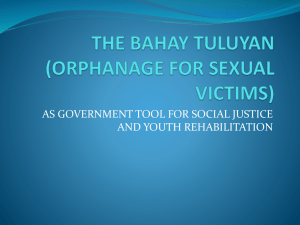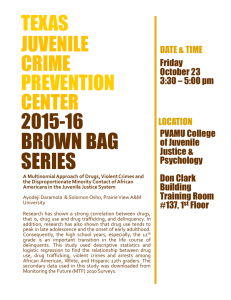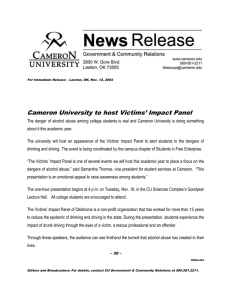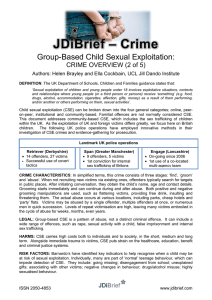The Government of the Republic of Korea’s Response to the... of the Special Rapporteur on the ...
advertisement
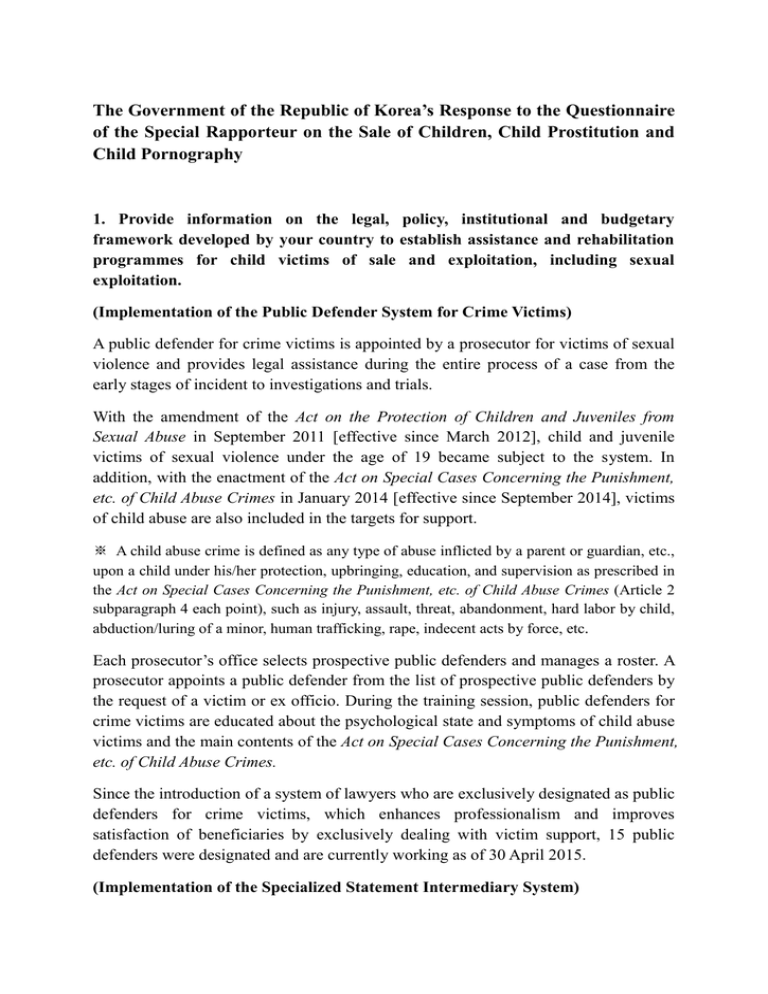
The Government of the Republic of Korea’s Response to the Questionnaire of the Special Rapporteur on the Sale of Children, Child Prostitution and Child Pornography 1. Provide information on the legal, policy, institutional and budgetary framework developed by your country to establish assistance and rehabilitation programmes for child victims of sale and exploitation, including sexual exploitation. (Implementation of the Public Defender System for Crime Victims) A public defender for crime victims is appointed by a prosecutor for victims of sexual violence and provides legal assistance during the entire process of a case from the early stages of incident to investigations and trials. With the amendment of the Act on the Protection of Children and Juveniles from Sexual Abuse in September 2011 [effective since March 2012], child and juvenile victims of sexual violence under the age of 19 became subject to the system. In addition, with the enactment of the Act on Special Cases Concerning the Punishment, etc. of Child Abuse Crimes in January 2014 [effective since September 2014], victims of child abuse are also included in the targets for support. ※ A child abuse crime is defined as any type of abuse inflicted by a parent or guardian, etc., upon a child under his/her protection, upbringing, education, and supervision as prescribed in the Act on Special Cases Concerning the Punishment, etc. of Child Abuse Crimes (Article 2 subparagraph 4 each point), such as injury, assault, threat, abandonment, hard labor by child, abduction/luring of a minor, human trafficking, rape, indecent acts by force, etc. Each prosecutor’s office selects prospective public defenders and manages a roster. A prosecutor appoints a public defender from the list of prospective public defenders by the request of a victim or ex officio. During the training session, public defenders for crime victims are educated about the psychological state and symptoms of child abuse victims and the main contents of the Act on Special Cases Concerning the Punishment, etc. of Child Abuse Crimes. Since the introduction of a system of lawyers who are exclusively designated as public defenders for crime victims, which enhances professionalism and improves satisfaction of beneficiaries by exclusively dealing with victim support, 15 public defenders were designated and are currently working as of 30 April 2015. (Implementation of the Specialized Statement Intermediary System) During investigation and trial, child victims of sexual violence or abuse may be subject to secondary damages due to difficulty in communication arising from their frail ability to understand or set forth the details about the case. A Specialized Statement Intermediary is a specialist who assists such child victims by participating in the process of investigation or trial from a neutral stance. A Specialized Statement Intermediary mediates or facilitates communication between the victim and investigative/trial authorities and thereby supports the victim’s statements in criminal justice procedures. The amendment of the Act on Special Cases Concerning the Punishment, etc. of Sexual Violence in December 2012 [effective since June 2013] makes victims of sexual violence eligible for the system. The enactment of the Act on Special Cases Concerning the Punishment, etc. of Child Abuse Crimes in January 2014 [effective since September 2014] provides legal grounds for making victims of child abuse crimes eligible for Specialized Statement Intermediary assistance. Accessibility of the services of the Specialized Statement Intermediary is guaranteed with the ex officio of investigative authorities or the court, or the request of the victim or his/her legal representative. (Establishment of the Protection Fund for Victims of Crimes) In order to raise funds needed for the protection and support of victims of crimes, the Ministry of Justice established the Protection Fund for Victims of Crimes in 2011. In accordance with the Crime Victim Protection Fund Act and its enforcement decree, finances were secured by donation and a certain amount (6%) of fines was enforced. In 2015, the total value of the fund amounted to 91.5 billion won. The fund is used for financing each of the support projects for victims of crimes carried out by the Ministry of Justice, Ministry of Gender Equality and Family, Ministry of Health and Welfare, etc. Protection and support for child victims of exploitation are provided by the Ministry of Health and Welfare’s protection and support project for victims of child abuse. As of 2015, the project is under a budget of 19.5 billion won. (Criminal Penalties for Sale of Children) Under the Child Welfare Act (Article 71 paragraph 1 subparagraph 1), any person who engages in trading children under the age of 18 shall be punished by imprisonment for not more than ten years. Under the Act on the Protection of Children and Juveniles from Sexual Abuse (Article 12), any person who deals in or sends a child or juvenile to a foreign country, knowing that he/she will become an object of the purchase of child or juvenile sex, shall be punished by imprisonment for life or for not less than five years. (Protection of victims of sexual trafficking) The Korean government has enacted and implemented the Act on the Prevention of Sexual Traffic and Protection, Etc. of Victims (proclaimed on 22 March and enforced on 23 September of 2004) in order to prevent sex trading, including human trafficking for sexual exploitation, to protect victims of sexual trafficking and persons who have sex with people in exchange for money, and to support their self-reliance. The types of support facilities for the victims of sexual trafficking include counseling centers, general & juvenile support institutions, foreign women victim support centers, rehabilitation support centers, and group homes. These facilities provide victims with lodging, counseling, medical treatment, medical and legal assistance, rehabilitation and self-reliance education, as well as job information. Protection of and assistance for the victims of sex trafficking are provided mostly through the shelters and support centers operated by NGOs. The operating expenses of these facilities are largely subsidized by matching funds from central and regional governments. In particular, the government is operating juvenile support institutions and alternative education institutions for juvenile victims of sex trafficking. Juvenile support institutions provide victims with diverse assistance including accommodation and meals, counseling, medical and legal support, rehabilitation and self-reliance education, job information, education for school entrance, and connection with educational institutions, until the victims reach age 21. * Juvenile support institutions (15 locations): 627 residents/users per year * Total number of assistance provided by type in 2014 Total Medical Aid Legal Aid Vocational Training Education Rehabilitatio for n Program Schooling 16,102 4,090 367 294 817 10,534 In addition, Ministry of Gender Equality & Family (MOGEF) has two consigned alternative education centers for complementing discontinued schooling of juvenile victims and providing learning opportunities such as rehabilitation programs. * Consigned alternative education centers (2 locations): 80 student intake and 30 graduates in 2014. MOGEF has been carrying out a diverse range of treatment and rehabilitation programs to help sexually exploited juveniles since 2006 based on Article 39 of the Act on the Protection of Children and Juveniles from Sexual Abuse as well as Article 8 and 9 of the Enforcement Decree. MOGEF annually spends approximately 1.1-1.2 billion dollars to implement 40 hours of basic and 20 hours of intensive education programs for the treatment and rehabilitation of juvenile victims through 1 central support center and 10 regional educational centers. It also provides one-year follow-up care services such as schooling and returning home support, medical support, and career guidance so as to prevent revictimization of teenagers in sex trafficking. Furthermore, to prevent the sale of children and juveniles for sexual purposes, MOGEF started Cyber Peer Counseling in 2013 through which teenagers who are in danger of sex trafficking via instant messaging services or smartphone applications could request online counseling for emergency relief and psychological aid. * 2015 Budget: 261 million KRW (approximately 244,000 USD) With an aim to further protect children and youth from any potential sexual crimes, MOGEF has also been implementing a reward system since March 2012, under which a person who reports sex trafficking involving children or youth would be granted monetary rewards. 2. Based on your experience, what elements are necessary for a comprehensive and right-based care and recovery system of child victims of sale and exploitation, including sexual exploitation? (Early identification and support for juvenile victims of sex trafficking) Juvenile victims need to be connected to immediate support systems such as real-time and onsite counseling programs. (Provision of professional education and support services ) Lodging, counseling, medical and legal assistance, education for school entrance, job information, etc., through juvenile support facilities and alternative education institutes Professional education on how to escape from sex trafficking to prevent victims from reengaging in sex trade and help them become healthy citizens Customized counseling by professionally qualified counselors, especially through lessons learned from case conferences and professional case management Self-reliance and rehabilitation support through continuous pre and post counseling services (Establishment of support network throughout the society) A social safety network through support group meetings and enhanced cooperation with relevant organizations to provide better coordinated services to the victims 3. Provide examples of good practices and successful initiatives of assistance and rehabilitation programmes which facilitate the rehabilitation and reintegration of child victims of sale and exploitation, including sexual exploitation. (Establishment of National Action Plan) In March 2012, the Government established the Second National Action Plan for the Promotion and Protection of Human Rights (2012-2016), a nation-wide, comprehensive plan of human rights policies, and is currently in the process of implementing it. The Second National Action Plan includes the following tasks: 1) Strengthening punishment for human trafficking and sale of children; 2) encouraging reports of child abuse and improving protection and support for victims of child abuse; and 3) continuing youth specific support for juvenile victims of sex trafficking. - By implementing the abovementioned tasks, provisions were established with the amendment of the Criminal Act in April 2013; one that punishes human trafficking and another that punishes acts of abducting/luring a person with the purpose of exploiting labor and sex trafficking, etc. - From January to June 2013, the scope of persons liable for reporting child abuse was expanded and the obligation to report was strengthened. - Regular school lessons and specialized education, psychological treatment programs, and rehabilitation education, etc., for juvenile victims of sex trafficking were carried out and support facilities for juvenile victims of sex trafficking were managed. Implementation of the National Action Plan is reviewed every year by the Human Rights Policy Advisory Board which consists of various professionals of academic, legal or religious, etc., fields. The results of the implementation is confirmed by the National Human Rights Policy Council, which is chaired by the Minister of Justice with the participation of vice-ministerial level members of relevant ministries and organizations, as a consultative and coordinative organization for human rights policies, and made public thereafter. By offering a wide range of programs such as art, music, dance and play therapies, as well as boot camps, MOGEF has achieved positive results in treating trauma of the victims who suffered from sex trafficking and family crisis. In this regard, the government has been providing necessary financial support for the continued operation of these programs. - Utilizing juvenile support facilities and alternative education institutes A runaway teenager who had repeatedly engaged in sex trade was admitted into a juvenile support facility with the help of her school. She received medical and legal aid, lodging, and psychological treatment using sand and musical instruments while participating in summer boot camps run by an alternative educational institute affiliated with the support facility. After completing middle and high school curriculums, she was accepted to a 4-year college to study social welfare. - Utilizing treatment and rehabilitation programs A juvenile started to receive online counseling and participated in pre-program counseling and education, more than 15 one-on-one psychological counseling, and support group meetings. The teenager also received legal assistance in reporting a sex trader, medical aid for obstetric examinations high-school entrance information, and pair-up service with internship centers. Through comprehensive and professional assistance, the at-risk youth successfully returned to society, and is currently welladjusted at a high school. 4. Describe the challenges that your country has identified in the establishment and management of assistance and rehabilitation programmes for child victims of sale and exploitation, including sexual exploitation. As juvenile victims of sexual exploitation often suffer from social isolation, stereotyping and stigmatization, and intensified fear and frustration, it is necessary to povide them with continuous and comprehensive assistance so that they may completely escape from the temptation of sex trading. In addition, it is also important to increase victims’ self-reliance and rehabilitation, and pursue prevention policies to stop them from reengaging. However, most victims are extremely hesitant and concerned about their identification being exposed, which in return prohibits their active participation in the rehabilitation programs. For this reason, encouraging the victims to enroll in the programs has been the most challenging task. 5. How do you ensure that the views and needs of children are duly taken into account in the design and provision of care and recovery services? MOGEF strived to reflect the interests and desires of juvenile victims in support programs by gaining insight through online, phone and onsite counseling sessions. The government established an intensive education course and support group programs based on identified areas of interest and desires of participating juvenile victims in Youth Growth Camp of the treatment and rehabilitation program. 6. How do you ensure access of child victims to support services? In order to ensure the constitutional and legal rights of victims of crimes including child victims of exploitation, and to enable such victims to receive necessary support in a timely manner, provision on the ‘duty of notification on the rights of victims of crimes’ was established with the amendment of the Crime Victim Protection Act in October 2014. ※ Information given to crime victims by notification: rights of victims of crimes under criminal procedures, all possible economic, medical, and legal assistance including the monetary relief for criminal injuries, other information related to the protection of rights and the promotion of welfare of crime victims including the criminal reconciliation system. MOGEF is currently operating 26 counseling centers nationwide to provide victims of sex trafficking, including juveniles, with psychological, legal, and medical counseling as well as a variety of services. Youth victims in need of accommodation are referred to juvenile support facilities. Juvenile victims of sex trafficking can also get assistance through the 24/7 emergency hotline 1366 which was launched to provide counseling for women who are exposed to domestic and/or sexual violence and sex trafficking. In addition, the Cyber Peer Counseling program is in operation in connection with education centers for at-risk youth, where former juvenile victims of sexual exploitation provide peer counseling through internet chats or mobile applications. Furthermore, regional education centers for juveniles at risk carry out proactive onsite outreach activities to encourage youth’s participation in education programs. 7. How do you ensure the adoption of a gender perspective in the establishment and management of the assistance and rehabilitation programmes? Do the programmes provide gender-specific measures for the care and recovery of boys and girls? Shelters for the victims such as support facilities, rehabilitation centers, and counseling centers provide a wide range of services for victims of sex trafficking and those who are accused of sex trade, regardless of their gender. However, as the victims have been mostly women, protection and rehabilitation services have been developed to accommodate the needs of women. For gender perspective education, MOGEF has opened two lectures, Understanding Sex Trafficking and Understanding Gender-Sensitiveness (Sexuality), in the basic and intensive education courses of the treatment and rehabilitation programs for the juvenile victims. 8. Provide information on prevention programmes developed by your country with a specific focus on children at risk or in vulnerable situation (e.g. children working and/or living on the street, children placed in institutions, unaccompanied migrant children). Juveniles in the Juvenile Training Schools and the Juvenile Classification Review Boards are provided with sexual violence prevention education that focuses on the proper understanding of sex, ways of reporting and coping with sexual violence, etc. Moreover, those juveniles placed in the Juvenile Training Schools who have experienced sexual violence may participate in sexual assault treatment programs and learn ways of expressing and healing their sexual abuse experiences and coping with sexual abuse, etc. There are a total of 119 juvenile shelters nationwide for runaway teenagers who lack sufficient support from family or school. - The shelters conduct early identification, temporary protection, and delinquency or derailing prevention activities, while providing basic living support (clothing, food and shelter), counseling, education, and cultural activities. The major objective of these shelters specializing in runaway youth protection and support is to promote faster return to families and society, and healthy growth of the teens. * In 2014, a total of 24,000 runaway teenagers were admitted to juvenile shelters, and about 6,300 of them returned home and received employment support.

